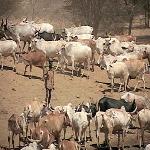22 September 2010

Photo: VOA Photo - C. Majtenyi
A herder in Kenya tends to his cattle, Aug 2010
In Kenya, the specter of drought is never far from the minds of the millions who make their living on the farm.
Agriculture is Kenya's most important product. The industry employs nearly three quarters of the country's workers and accounts for almost one fifth of the nation's gross domestic product.
Drought threatens the livelihoods of tens of millions in Kenya, but those most at risk are the millions who farm simply to survive. For those farmers, drought is both an economic risk and a life threatening event.
Many subsistence farmers in Kenya invest their life savings into each harvest, and a single season of light rain can set a family back for years.
In 2007, unusually low rainfall triggered a food shortage, sending food prices up and prompting calls for price controls. The effects of that drought continued through late 2009, when unusually heavy rains provided a rare surplus for the country.
In east Africa, serious drought is expected about once per decade. But recent reports of a La Nina weather system in the Pacific have many predicting yet another season of insufficient rain.
To protect against such uncertainty, small farmers often plant different seed varieties to guarantee at least some returns on their investment. Planting different types of drought resistance crops can help cover risk, but lead to reduced yields and keep farmers living from season to season.
Harvest insurance can protect against crop failures, but such services are expensive and typically unavailable to farmers. Insurance premiums can reach thousands of dollars, while many small farmers invest less than $100 in each season's crop. Small farmers often work in remote areas, making site visits by insurance companies difficult and expensive.
But through a new partnership between UAP Insurance, telecommunications firm Safaricom and Swedish non-profit Syngenta, Kenyan farmers can buy insurance on seed and fertilizer to protect against potential losses.
The product, called Kilimo Salama - which means "safe agriculture" in Swahili - harnesses mobile technology and new agricultural technology to provide insurance on a smaller scale.
Instead of insurance inspectors, Kilimo Salama has installed stations across the country that measure weather patterns and predict how harvests will be affected. These unmanned stations wirelessly transmit data to a central database that is used to calculate losses and distribute payments to farmers.
According to Sygenta spokesperson Rose Goslinga this method, known as weather indexing, provides an efficient and cost effective way of calculating risk on small farms.
"That weather station measures what goes on, on the farmers' fields and is essentially a representation of the insurance. So you do not have to send anybody to go and check what happens on the farm," she said. "This means you reduce your transaction costs. Instead of having to go and visit, you now can see 100 farmers, who all maybe have one acre and measure what goes on, on their farm."
Another unique aspect of the insurance is the way in which farmers are paid. When weather stations detect a potential crop loss, insurance payments are automatically made to farmers via mobile phone.
The product utilizes Safaricom's heralded M-Pesa service, which allows customers to send and store money with mobile phones. On July 21, Kilimo Salama made its first payouts via M-Pesa. The average payout was around $22, though some were as small as $1 and others as large as $3,500.
Through mobile phones, Kilimo Salam also provides updates to farmers as well as tips for growing crops in challenging regions.
Kilimo Salama is still in development, but the program appears to be catching on. First launched in 2009, around 200 farmers were insured. This year, the program covers approximately 11,000 farmers across Kenya.
A farmer from Siakago in Kenya's Eastern Province, Lydia Njagi, first tried Kilimo Salama insurance out of curiosity.
Njagi says she initially insured around $5 worth of seed before the current growing season. After weather stations predicted a 15 percent reduction in crop yields Njagi received an initial payment of around one dollar, with more to come if the weather trends continue. Njagi told VOA she was initially skeptical of the product, but would insure more of her crop for the next season.
Many of Siakago's farmers told VOA they were happy with the Kilimo Salama program, and many more could be seen lining up to purchase the insurance for the first time.
While the insurance program is only available for seed and fertilizer produced by brands certified by the group, Goslinga told VOA the group planned to expand the project and open it up to other producers in the future.
Kilimo Salama has 30 weather stations that cover climate zones about 15 to 20 kilometers in area. Only five areas in Kenya are currently covered, but the group hopes to build an additional 50 stations this year to cover more farmers by the start of the next season.